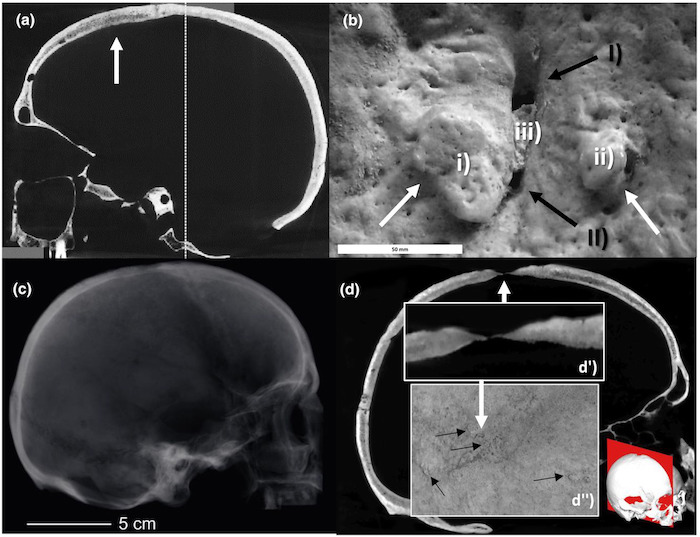Two head operations on a woman were performed in the Marche region under the Longobard Kingdom. Started in the 6th century AD and ended with Charlemagne’s conquest, the Longobard Kingdom, narrated in Manzoni’s tragedy Adelchi, controlled almost the whole Italian peninsula in its heyday, except for Rome, Sicily, Sardinia and the southern part of Apulia and Calabria.
In the cemetery of Castel Trosino, near Ascoli Piceno, a Longobard necropolis has been found. In one of the tombs excavated, an older woman’s skull has come to life, showing the first evidence of a cross-shaped bone modification on a living person.
Macroscopic, microscopic and CT scan analyses revealed at least two sets of scraping marks. Specifically, SEM analysis has shown perimortem bone-scraping traces. Both healed and non-healed defects suggest that the woman received at least twice intentional bone modifications to deal with her condition. It is the first evidence of a cross-shaped therapeutic intervention on a living individual.
Remains were analysed by an international research team, co-ordinated by the Sapienza University of Rome, Cambridge University, the Spanish University of Zaragoza, the French National Centre for Scientific Research (CNRS) with the help of Milan’s Catholic University of the Sacred Heart. The results were published in the International Journal of Osteoarchaeology.
Researchers, under the guidance of Ileana Micarelli of Cambridge University and former post-doctoral researcher at La Sapienza, studied the woman’s skull, revealing signs of at least two head operations. In addition, using new high-resolution biochemical research methods on one of her teeth, they were able to understand changes in the woman’s diet and movements from her early years to adulthood, showing signs of treatment provided to her by the community.
Giorgio Manzi, study co-ordinator at Sapienza University, says: “The last cranial surgery seems to have been performed shortly before her death”. He also adds: “There are no lesions to suggest the presence of injury, tumours, congenital or other diseases. It is interesting to consider the possibility of a ritual or judicial reason behind these operations, but at the moment we do not have any evidence for this”.
Castel Trosino was an extremely sensitive site in the complex political situation which developed after the collapse of the Roman Empire, during the Post-Classical period. After losing the Po Valley, the Byzantine government established its military control over central Italy. That is why, during the 6th century AD, Castel Trosino became a strategic site.
The archaeological literature describes it as having a non-preeminent military function. Indeed, the first Longobard phase at Castel Trosino started in the last decade of the 6th century AD. Most likely, it was due to a small group of soldiers guided by war chiefs wearing imperial insignia. They aimed to repay barbarian leaders, allied with the imperial government, and ensure peace in the region. This was the main reason why the Byzantine authorities encouraged Longobard elites to conquer Castel Trosino.
Castel Trosino became the residence of many prestigious families, as shown by the stunning funerary goods recovered (gold objects and fine jewellery). As unique Post-Classical Italian funerary goods, these pieces are primarily of Roman-Byzantine manufacture and are closely linked to the customs of the Byzantine and Longobard society.

